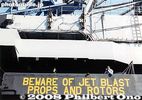 Image search results - "yokosuka" Image search results - "yokosuka" |

Following the USS Midway, the USS Independence was the second forward-deployed US aircraft carrier in Japan. It was based in Yokosuka during 1991-98.
|
|
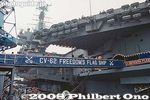
I went with a group to tour the USS Independence while it was homeported at Yokosuka. All the planes were gone, flown to Atsugi.
|
|

CV-62 Freedom's Flagship is nicknamed "Indy." Commissioned in 1959.
|
|

Elevator
|
|
|
|
|
|
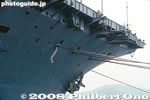
Bow and anchor
|
|
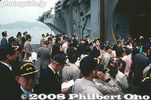
Riding on the elevator to the flight deck.
|
|

The elevator is normally used to carry planes up to the flight deck.
|
|
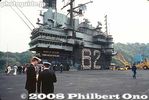
Flight deck of the USS Independence. The island or control tower can be seen.
|
|
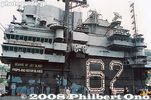
Control tower of the Indy.
|
|
|
|

Flight deck of the USS Independence.
|
|

Catapult
|
|

We all received a cap.
|
|

Nets along the edge function as a safety net for any crew who has to jump off the flight deck.
|
|

The flight deck is dotted with these lugs used to tie down the planes.
|
|
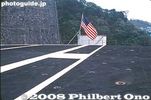
Fan tail
|
|

Sailor
|
|
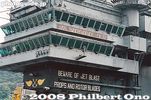
Bridge
|
|
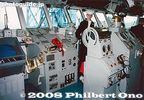
Inside the bridge
|
|
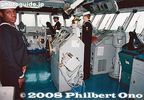
Bridge
|
|

"Welcome aboard!"
|
|
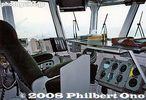
Captain's seat. We took turns sitting on it for pictures.
|
|
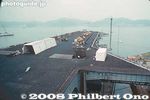
View of the flight deck from the bridge.
|
|

Bridge windows
|
|
|

Inside the USS Independence
|
|

Submarine moored in the next berth.
|
|

Sailor
|
|

Hangar below deck. The USS Independence was decommissioned in Sept. 1998.
|
|

This is the USS Midway which I also toured with a group while it was still homeported in Yokosuka during 1973-1991. The first US aircraft carrier to be homeported outside the US.
|
|
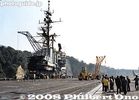
Flight deck of the USS Midway.
|
|

USS Midway control tower
|
|
|

USS Midway flight deck
|
|

There were no planes on the carrier when we visited. They were all at Atsugi. This jet was gutted and used only for ground crew training.
|
|
|
|

Elevator on USS Midway
|
|
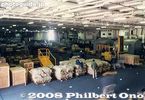
USS Midway hangar. The ship is now a museum in San Diego, California.
|
|

Keikyu Yokosuka-Chuo Station platform, arrival from Tokyo. 京急横須賀中央駅
|
|

Keikyu Yokosuka-Chuo Station. This is Yokosuka's main train station. The major shopping areas as well as the US Navy Base are nearest to this train station.
|
|

Upper deck ("Y deck") connects the train station with a shopping complex. Central Yokosuka is quite compact, and almost everything is within walking distance.
|
|

Yokosuka is a "Curry Town." Curry rice was popularized by the Japanese Imperial Navy in the 19th century.
|
|

Banner marking the 10th anniversary of Yokosuka's self-proclaimed "Curry Town." The Japan Maritime Self-Defense Force eat curry rice for lunch every Friday, including those in Yokosuka. It's called "Kaigun curry" (Navy curry).
|
|

Banner near the train station congratulating Yokosuka-native Nishiyama Rei for winning the gold medal in women's softball at the Beijing Olympics in 2008.
|
|

View of Yokosuka Chuo Street, the main drag lined with shops and restaurants.
|
|

View of Yokosuka Chuo Street at night.
|
|

Inside Mikasa Plaza, an indoor shopping arcade along Yokosuka Chuo Street.
|
|

Street sculptures of jazz musicians along Yokosuka Chuo Street. Yokosuka has a jazz history.
|
|

Yokosuka Chuo Street.
|
|

Club Alliance and gate to the US Navy Base.
|
|

Shopping center where most people shop in central Yokosuka. Despite this megamall, the other shopping areas in town are still thriving. Yokosuka has a vigorous atmosphere. Not economically depressed.
|
|

Route 16 in Yokosuka, the main road.
|
|

Yokosuka Post Office
|
|

"Mikasa" is a key word in Yokosuka.
|
|

Uraga and Kurihama are nationally famous as the place where Commodore Matthew Perry arrived in Japan in July 1853. This is on the Miura Peninsula at the mouth of Tokyo Bay.
|
|

Drawing of Perry by local junior high school students in Uraga. This is near Uraga Station. Uraga and Kurihama are a short train ride from Yokosuka Chuo Station.
|
|

JR Kurihama Station is not far from the Keikyu Kurihama Station, but there's hardly anything near this station.
|
|

Keikyu Kurihama Station is Kurihama's main train station with shopping arcades. The beach is also within walking distance. 京急久里浜駅
|
|

Shopping arcade in front of Keikyu Kurihama Station. Walk down this road to go to the beach.
|
|

Kurofune Ichiba shopping arcade. "Kurofune" means black ship, in reference to Commodore Perry's ships.
|
|

Inside Kurofune Ichiba shopping arcade.
|
|

Black ship on the sidewalk.
|
|

Kurihama beach, where Commodore Perry landed on July 14, 1853.
|
|

Car ferry arriving Kurihama Port from Kanaya, Chiba, across Tokyo Bay.
|
|
|
|

Kurihama is easy to spot on the Miura Peninsula with these smoke stacks.
|
|

Kurihama beach, where Commodore Perry first landed in Japan.
|
|

Perry Road and way to Perry Park.
|
|

Way to Perry Park.
|
|

Restaurant named "Kurofune."
|
|

Perry Park faces the beach. It has the Perry Monument marking Perry's landing in Kurihama. ぺりー公園
|
|

The Perry Monument was originally built in 1901 by a US friendship association to mark the landing of Perry. ぺりー上陸記念碑
|
|

The monument words were written by Ito Hirobumi (Japan' first Prime Minister). It says, "Monument Commemorating the Landing of Navy Commodore Perry from the United States."
|
|

"Monument in Commmemoration of the Landing of Commodore Perry, USN - Marquis Hirobumi Ito Grand Order of Chrysanthemum"
|
|

Ship anchors flank the Perry Monument
|
|
|

Plaque at the monument foot shows a map of Perry's voyage.
|
|
|

The back of Perry Monument.
|
|

The back of the Perry Monument in Kurihama.
|
|

The back of the Perry Monument in Kurihama.
|
|
|

Near the Perry Monument is the Perry Memorial Hall (Perry Ki'nenkan). Hours: 9:00 am - 4:30 pm, closed Mon. (open if a nationa holiday and closed Tue. instead). Phone 046-834-7531 ペリー記念館
|
|

Bust of Commodore Perry at the entrance of Perry Memorial Hall
|
|

Bust of Lord Toda at the entrance of Perry Memorial Hall
|
|

First floor of Perry Memorial Hall has a portrait of Perry and a diorama. This small museum opened on May 1, 1987.
|
|

Black Ship diorama
|
|

Second floor of Perry Memorial Hall has the main exhibits.
|
|

Portrait of Commodore Perry
|
|

Map showing where Perry's Back Ships went. One ship went as far as Haneda.
|
|

Painting depicting Perry's landing at Kurihama to meet the local magistrate.
|
|
|
|
|

Letter from Perry to his daughter.
|
|

Arch at the entrance to Mikasa Park.
|
|

Mikasa Park. A short walk from the train station is this waterfront park featuring the Battleship Mikasa preserved on dry land as a museum.
|
|

Statue of Admiral Togo who led Japan to victory during the Battle of Tsushima over Russia in 1905.
|
|

Statue of Admiral Togo
|
|

Battleship Mikasa, the flagship of the Japanese Imperial Navy during the Russo-Japanese War in 1905. 三笠
|
|

Bow
|
|

Middle
|
|

Aft with the Rising Sun flag.
|
|

The ship has been very well restored. It was built in 1902 in the UK. It became a memorial ship in 1926, later fully restored in 1961.
|
|

Gold Imperial crest on the bow.
|
|

Guns
|
|
|
|
|
|
|

Lifeboats
|
|

The bridge
|
|

Bow deck as seen from the bridge.
|
|

Outside the bridge.
|
|
|

Inside the Battleship Mikasa.
|
|

Conference room
|
|

Captain's quarters
|
|
|

Lower deck
|
|

Display of model boats by elementary school children on the lower deck.
|
|

A winning entry. Model of the Mikasa.
|
|

Waterfront of Mikasa Park. The Navy base can be seen.
|
|

Sarushima island as seen from Mikasa Park. Sarushima means Monkey Island. No monkeys there though. Too bad it does not look like a battleship. The only natural island in Tokyo Bay.
|
|

Ferry terminal for Sarushima island, next to Mikasa Park. Only 15 min. to Sarushima. 1,200 yen round trip. Boats run once an hour, 8:30 am to 5 pm.
|
|

New cars being driven into the car ship for export.
|
|

Even this apartment building has a battleship motif.
|
|

Verny Park is on the waterfront facing the Navy Base.
|
|

Military protests are held here.
|
|

You can see the navy base from this park, but can't really see the US navy ships.
|
|

Rose garden
|
|

Verny Park gives a view of one side of the navy base.
|
|

Submarines of the Japanese Maritime Self-Defense Force.
|
|

Tower of the USS George Washington aircraft carrier. This is all you can see of the carrier while it is in port.
|
|

Old guard posts of the Imperial Navy in Verny Park.
|
|

Verny Park waterfront. People tried to see the USS George Washington arrive, but in vain. The Verny Commemorative Museum can be seen in the rear.
|
|

Inside the Verny Commemorative Museum is a giant steam hammer used to stamp metal objects. Free admission.
|
|

Sign says "No gatherings without permission." Such "gatherings" refers to protests against the military.
|
|

Busts of Francois Verny and Lord Oguri Kozukenosuke Tadamasa who laid the foundation for Yokosuka.
|
|

Bust of Francois Verny, a French engineer who established the Yokosuka Arsenal. The park is named after him.
|
|

Navy monument in Verny Park
|
|

Navy monument in Verny Park
|
|

Navy monument in Verny Park
|
|

The famous Dobuita Street with military shops, bars, etc. "Dobu" means sewer, and "ita" is plank. They once had wooden planks covering a sewer gutter running down the street.
|
|

Dobuita Street wasn't so impressive. Looks very well cleaned up though. I figure most people instead go to Yokohama for night life.
|
|

The street was likely more raunchy and infamous during the 1960s.
|
|
|
|

Yokosuka jackets
|
|

Profanity is bad for the children...
|
|

Old porn theater in Yokosuka. Pretty amazing to see one these days, in the age of DVD/video rentals and Internet. It's almost a cultural icon.
|
|

Kannonzaki Park juts into Uraga Channel, the mouth of Tokyo Bay. It is a large park on a cape with walking paths and a lighthouse. 観音崎公園
|
|

Kannonzaki Park
|
|

The shore is rocky.
|
|

Lots of ships pass by here.
|
|
|

Cape Kannonzaki is at the tip closest to Uraga Channel, the narrow mouth of Tokyo Bay. Ships must pass through here to enter or depart Tokyo Bay.
|
|

Container ships, oil tankers, passenger ships, navy ships, etc., all pass through here. Anybody have a picture of an aircraft carrier passing by here?
|
|

If you like ship watching, come to Kannonzaki. This is the Nippon Maru cruise ship. にっぽん丸豪華クルーズ船
|
|

Walking path around Kannonzaki Park.
|
|

Cave
|
|

Lookout point at Kannonzaki Park.
|
|
|

Looks like the devil's washboard.
|
|
|

Walking path around Kannonzaki.
|
|

This park is closed for some reason.
|
|

Types of ships that pass by.
|
|

Map of Kannonzaki drawn by Commodore Perry when he first arrived in 1853.
|
|
|
|

Kurihama in the distance.
|
|
|

More ships
|
|

Kurihama in the distance.
|
|
|
|
|

Tatara-hama Beach
|
|

Shaped like a lighthouse.
|
|

Kannonzaki Lighthouse built in 1925. It stands 19 meters high, and 56 meters high from sea level. 観音灯台
|
|

The Kannonzaki Lighthouse is a short uphill climb from shore. The original lighthouse was Japan's first Western-style lighthouse built in the late 19th century by Verny. Destroyed by an earthquake in 1922, and again by the 1923 Kanto Earthquake.
|
|

Light of the lighthouse.
|
|

Spiral stairs inside the Kannonzaki Lighthouse.
|
|

View of Uraga Channel from Kannonzaki Lighthouse
|
|

View of Uraga Channel from Kannonzaki Lighthouse
|
|

View of Uraga Channel from Kannonzaki Lighthouse
|
|

Lighthouse artifacts displayed outside. Foghorn on the far right.
|
|

Other lighthouse monuments
|
|
|
|
|



































